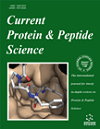- Home
- A-Z Publications
- Current Protein and Peptide Science
- Previous Issues
- Volume 19, Issue 10, 2018
Current Protein and Peptide Science - Volume 19, Issue 10, 2018
Volume 19, Issue 10, 2018
-
-
Chemotherapeutic Drugs and Plasma Proteins: Exploring New Dimensions
More LessIn the last few decades, advances in the cancer chemotherapy have been a marked success. A large number of anticancer drugs currently in use include drugs based on platinum complexes such as cisplatin, base analogues such as 5-florouracil and some ruthenium drugs. This review provides a bird's eye view of interaction of a number of clinically important drugs currently in use that show covalent or non-covalent interaction Read More
-
-
-
Protein-protein Interactions and their Role in Various Diseases and their Prediction Techniques
More LessAuthors: Gulam Rabbani, Mohammad H. Baig, Khurshid Ahmad and Inho ChoiProtein-protein interaction (PPI) is necessary for most of the biological processes and requisite for host-pathogen communication. Most of the threatening human diseases are caused by different types of interactions of proteins with their prior infected proteins or with pathogen's proteins. Understanding of involved mechanisms of interacting pairs, functional domains and characterizing specific molecular interaction of host Read More
-
-
-
Immunogenicity in Protein and Peptide Based-Therapeutics: An Overview
More LessAuthors: L. Fernandez, R.H. Bustos, C. Zapata, J. Garcia, E. Jauregui and G.M. AshrafCurrently it is well known that all biological drugs, including those with a fully human structure, are capable of inducing a host immune response known as immunogenicity [1]. The presence of ADAs can condition the drug´s level and action, thus modifying the therapeutic effect and even the safety profile by its mechanism of action - neutralizing or non-neutralizing - and / or an increase in its clearance. Immunogenicity is a dy Read More
-
-
-
Polymer Based Protein Therapeutics
More LessProteins have played a very important role in the drug industry for developing treatments of various diseases such as auto-immune diseases, cancer, diabetes, mental disorder, metabolic disease, and others. Therapeutic proteins have high activity and specificity but they have some limitations such as short half-life, poor stability, low solubility and immunogenicity, so they cannot prolong their therapeutic activity. Thes Read More
-
-
-
Disorder in Milk Proteins: Lactadherin Multifunctionality and Structure
More LessMilk fat globule membrane (MFGM) is one of the milk components that is produced by the lactating mammary glands and released to the milk in the form of vesicles. MFGM surrounds milk fat globule secreted by the milk producing cells and has a complex structure containing various lipids (e.g., triacylglycerides, phospholipids, and cholesterol), proteins and other macromolecules. Among the proteinaceous components of M Read More
-
-
-
The Development of Peptide-based Antimicrobial Agents against Dengue Virus
More LessAuthors: Yen-Wei Huang, Chun-Ting Lee, Ta-Chen Wang, Yun-Chung Kao, Chih-Hui Yang, Yu-Mei Lin and Keng-Shiang HuangDengue fever has become an imminent threat to international public health because of global warming and climate change. The World Health Organization proclaimed that more than 50% of the world's population is at risk of dengue virus (DENV) infection. Therefore, developing a clinically approved vaccine and effective therapeutic remedy for treating dengue fever is imperative. Peptide drug development has become a n Read More
-
-
-
Interactions of Dietary Fibre with Nutritional Components on Gut Microbial Composition, Function and Health in Monogastrics
More LessAuthors: Seidu Adams, Dongsheng Che, Guixin Qin, Han Rui, Cornelius T. Sello and Jiang HailongThe relation between dietary fibre and the well-being of human and other monogastrics has recently became a hot topic as shown by the increasing number of publications of the related research. The aim of this review is to describe - through a logical approach - the scientific suggestion linking possible benefits of dietary fibre on nutritional components and their effect on the gastrointestinal composition in rela Read More
-
-
-
Exposure of Aggregation-Prone Segments is the Requirement for Amyloid Fibril Formation
More LessAuthors: Shreya Pramanik and Basir AhmadArranging into well-organized fibrillar aggregate, commonly known as amyloid fibril is an inherent property of any polypeptide chain. Amyloid fibrils are associated with a number of severe human pathologies like the Alzheimer's disease, Parkinson's disease, type2 diabetes and many more. Recent studies suggest that most of the fibrils are inert and extremely stable, thus could be used for the bionanotechnological applicatio Read More
-
Volumes & issues
-
Volume 26 (2025)
-
Volume 25 (2024)
-
Volume 24 (2023)
-
Volume 23 (2022)
-
Volume 22 (2021)
-
Volume 21 (2020)
-
Volume 20 (2019)
-
Volume 19 (2018)
-
Volume 18 (2017)
-
Volume 17 (2016)
-
Volume 16 (2015)
-
Volume 15 (2014)
-
Volume 14 (2013)
-
Volume 13 (2012)
-
Volume 12 (2011)
-
Volume 11 (2010)
-
Volume 10 (2009)
-
Volume 9 (2008)
-
Volume 8 (2007)
-
Volume 7 (2006)
-
Volume 6 (2005)
-
Volume 5 (2004)
-
Volume 4 (2003)
-
Volume 3 (2002)
-
Volume 2 (2001)
-
Volume 1 (2000)
Most Read This Month
Article
content/journals/cpps
Journal
10
5
false
en


